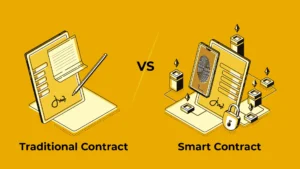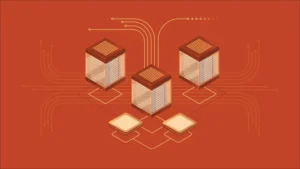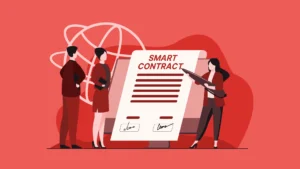
In the journey of technology, there lies a moment when the familiar meets the new, the trusted meets the disruptive. I still remember the time I first wrote a simple “Hello World” program in school, the thrill of making something respond to my instructions. That traditional software world felt safe, predictable. You type code, you run it, you fix bugs, you deploy. But then came the era of the blockchain, and with it the notion of a “smart contract.” Suddenly, the code is not just reacting; it executes by itself, commits to terms, and becomes part of a ledger that no one controls alone.
Now, we stand at another turning point, the rise of smart contracts.
They’re not just software; they’re the future of digital trust.
But what makes smart contracts so different from traditional software, the apps and programs that run our phones, banks, and businesses? Let’s explore this transformation in simple, human terms.
Understanding the Basics
Before jumping into comparisons, let’s clear up what both terms really mean.
Traditional software is what most of us use every day, apps, websites, and programs that run on centralized systems. They rely on servers, coding teams, and user interaction to perform actions. For instance, when you transfer money through a banking app, that transaction passes through servers, APIs, and several human or institutional checkpoints before it’s confirmed.
On the other hand, smart contracts are like digital agreements that automatically execute once the terms are met. They’re built on blockchain networks such as Ethereum, Solana, or Hedera. Unlike traditional software, smart contracts operate on trustless automation; no one can alter them once deployed, and no third party is needed to verify their outcome.
If you’d like to learn more about how smart contracts work on blockchain, check out this detailed overview by Hedera. Think of them as “trust machines”, once they start running, no one can interfere, cheat, or delay the process.
[Also Read: What is a Smart Contract and How Does It Work on Blockchain]
Evolution of Digital Agreements
Back in the day, business agreements were paper-based, slow, error-prone, and dependent on human verification. Then came traditional software systems, which digitalized most of these processes. They made transactions faster, but the element of trust was still centralized; banks, companies, and governments controlled the systems.
Now, smart contracts have taken the next step. They remove the need for any central authority and ensure that every participant in a transaction can trust the outcome because it’s backed by code, not by human promises. This transformation is not just technical, it’s philosophical.
It’s about shifting from “trusting people” to “trusting code.”
How Traditional Software Works
Traditional software, while powerful and flexible, still depends on centralized infrastructure. It operates on owned servers, governed databases, and manual intervention. Even the most advanced apps and fintech platforms ultimately rely on human approval and centralized authentication.
Updates are frequent, maintenance is constant, and the trust model depends on the developer or the organization.
That’s not necessarily a bad thing; centralized systems are often faster and more adaptable. But in environments where transparency and trust matter most, traditional systems have limitations that smart contracts overcome beautifully.
Major Differences Between Smart Contracts and Traditional Software
| Feature | Smart Contracts | Traditional Software |
|---|---|---|
| Execution | Self-executing and automated; runs directly on a blockchain when pre-defined conditions are met. | Executed through user interfaces or manual processes, requiring human input or interaction to run. |
| Location | Stored on a decentralized blockchain network. | Typically hosted on central servers or distributed through installation files. |
| Transparency | Highly transparent; terms are visible to all network participants. | Transparency is limited to the owner or authorized users; terms are not publicly visible. |
| Immutability | Immutable; once deployed on the blockchain, the code cannot be altered or tampered with. | Not immutable; code can be modified, updated, or patched by developers at any time. |
| Intermediaries | Eliminates the need for intermediaries like lawyers, notaries, or banks. | Often requires intermediaries for execution, verification, and enforcement. |
| Modification | Difficult to modify after deployment, requiring a complex and sometimes new deployment process. | Easily modified and updated by developers. |
| Cost | Generally, lower transaction costs due to the elimination of intermediaries and automation. | Can have higher costs due to the involvement of intermediaries and manual processes. |
| Use Cases | Ideal for automated transactions, digital assets, decentralized finance (DeFi), and supply chain management. | Used for a vast range of applications, from productivity tools to operating systems. |
Automation vs. Human Touch
Let’s be honest, automation can be exciting and scary at the same time.
Smart contracts automate everything, removing the need for human action. That saves time and reduces costs, but it also takes away flexibility.
Traditional software, on the other hand, gives humans control. We can stop, fix, or improve things anytime. It’s like the difference between a robot that never sleeps and a human worker who can adapt and improvise.
Both have their place; the real magic happens when they work together.
In short:
Smart contracts = permanent and tamper-proof.
Traditional software = flexible but controlled.
Trust and Transparency in Action
People value honesty and fairness, and that’s exactly what blockchain promises.
Smart contracts are built on transparency. Every rule, transaction, and action is visible on the network. No hidden clauses, no fine print.
Traditional software is often a black box. Users can’t see what happens behind the scenes, and that’s where problems like manipulation or hidden fees can occur.
Transparency is becoming a human need in the digital world. We want to know where our money, data, and time go, and blockchain helps make that possible.
If you want a deeper understanding of how they compare in real-world business scenarios, check this detailed comparison by 101 Blockchains.
Security and Risk
Smart contracts are incredibly secure. Once deployed, no one can alter or delete them. But this immutability also means any bug or coding mistake is permanent.
Traditional software allows updates and fixes, which is safer for projects that require flexibility.
So, while smart contracts offer tamper-proof automation, they require careful auditing and error-free deployment.
That’s why companies often rely on professional blockchain developers or auditors before launching their contracts, because once it’s on the blockchain, it’s there forever.
[Also Read: Top Smart Contract Security Risks Every Developer Must Know]
Legal and Ethical Perspective
One of the biggest challenges for smart contracts is legal recognition. While they’re technically flawless, not all countries recognize them as legally binding agreements yet.
Traditional contracts, backed by law, are still stronger in that aspect. But the world is changing, and governments are now working on blockchain regulations to bridge that gap.
For anyone interested in how smart contracts fit into law and education, here’s an insightful read from Presidency University explaining what law students and professionals should know.
When to Use Smart Contracts vs Traditional Software
| Situation | Why It’s the Best Fit | Best Choice |
|---|---|---|
| You want fast, automatic execution with no human interference | Executes instantly when all conditions are met — no waiting, no middlemen | Smart Contract |
| The agreement is fully digital or blockchain-based (crypto payments, NFTs, DeFi) | Works smoothly in decentralized systems and is transparent for everyone involved | Smart Contract |
| Multiple parties in different locations who don’t fully trust each other | Blockchain ensures the contract is tamper-proof and visible to all | Smart Contract |
| The contract includes complex legal terms or needs court recognition | Flexible and accepted in existing legal systems | Traditional Software |
| You might need to change or cancel the agreement later | Can be updated or terminated easily with mutual consent | Traditional Software |
| The deal involves physical assets or services (like real estate, employment, or goods) | Allows detailed clauses, human judgment, and proper dispute resolution | Traditional Software |
Pros and Cons – Smart Contracts vs Traditional Software
Smart Contracts
Why people love them
- They run automatically so you do not have to wait for approvals, making the system feel reliable and effortless
- Fully transparent, allowing you to see every action which builds real trust
- Immutable, so once deployed no one can cheat or alter the rules
- Cost-effective because there are no intermediaries or hidden fees
- Highly secure, distributed across the blockchain, making tampering extremely difficult
Things to watch out for
- Hard to change once deployed, so fixing mistakes can be complex
- Requires skilled developers to ensure safe and bug-free code
- Legal recognition is still evolving in many countries
- Blockchain network fees, such as Ethereum gas fees, can increase costs
Traditional Software
Why it is still popular
- Flexible and can be updated or patched anytime giving a sense of security
- Easier to develop and maintain using familiar programming tools
- Widely accepted and understood, which makes it easy for users to trust
- Can easily integrate with other systems and applications
Challenges it faces
- Centralized, so a server crash or hack can affect all users
- Often requires intermediaries for verification and trust
- Hidden processes, meaning users cannot always see how it works behind the scenes
- Ongoing costs including maintenance, updates, and staff can become expensive
Real-Life Applications of Smart Contracts
Smart contracts are already revolutionizing industries across the globe:

- Finance (DeFi): Automating loans, trades, and payments without banks.
- Supply Chain: Tracking goods from factory to store, ensuring authenticity.
- Healthcare: Managing patient records and insurance claims securely.
- Gaming: Powering NFTs, player rewards, and asset ownership.
- Real Estate: Automating property transfers and lease agreements.
These aren’t just technical innovations; they’re real examples of trust through technology.
Why Traditional Software Still Matters
The biggest difference isn’t in how they work, it’s in how they build trust.
Traditional software asks you to trust people, organizations, or systems. Smart contracts ask you to trust the code itself. Once it’s written and deployed, it follows the rules exactly, no one can cheat, manipulate, or interfere.
That’s powerful. It means fairer systems, faster decisions, and fewer dependencies.
But it also means once deployed, mistakes can’t be easily fixed. So, both have pros and cons — one gives control, the other gives certainty.
Bring Your Ideas to Life with Smart Contracts
Work with Nadcab Labs to build smart contracts that run on their own — secure, fast, and built to make your business easier.
The Future of Smart Contracts
The future isn’t about choosing between the two, it’s about connecting them.
Imagine logging into a website (traditional software) that automatically triggers a blockchain-based payment (smart contract). You get the best of both worlds: human-friendly interfaces and machine-driven trust.
That’s the direction businesses are already heading toward, a hybrid model where decentralized logic meets human design.
Traditional or Smart? Let Your Code Do the Work
Traditional software and blockchain smart contracts may share the word “software,” but they differ profoundly. Traditional software evolves with updates and human oversight. Smart contracts, on the other hand, execute automatically, without intermediaries, creating a trustless ecosystem.
When you next write code, ask: Do I expect this to change often? Do I need transparency and decentralisation? Do I want the code to enforce itself? Your answer determines which path to choose.
Because ultimately, technology is not just about code, it’s about trust. And that’s the real difference between the world we knew and the world we’re building next.
Frequently Asked Question - Smart Contracts
What exactly is a smart contract?
A smart contract is a digital agreement that executes automatically when conditions are met. Think of it as a trust machine, it ensures fairness, transparency, and speed without requiring middlemen like banks or lawyers. It guarantees that once rules are set, they cannot be broken or altered.
How is a smart contract different from regular software?
Regular software relies on human input and can be updated or changed anytime, often requiring trust in organizations. Smart contracts are automated, transparent, and immutable on a blockchain. Once deployed, they execute exactly as programmed, without human interference, giving users a trustworthy and consistent digital agreement experience.
Can you change a smart contract after it’s deployed?
No, smart contracts are immutable once deployed on the blockchain. This ensures no one can tamper with or alter the agreement, providing security and fairness. However, if updates are needed, a new contract must be created, making planning and careful development essential before deployment.
Do smart contracts need banks or lawyers to work?
No, smart contracts eliminate the need for intermediaries. Payments, transfers, and agreements happen automatically according to the rules coded in the contract. This reduces costs, delays, and human errors, unlike traditional systems where banks, lawyers, or notaries often verify or enforce agreements.
Are smart contracts safe to use?
Yes, they are highly secure because they run on decentralized blockchain networks. Each transaction is verified by multiple nodes, making tampering nearly impossible. However, errors in coding can create vulnerabilities, so audits by experts are essential to ensure contracts function safely and as intended.
What can smart contracts be used for?
Smart contracts are versatile and perfect for automation and trust. They are widely used in decentralized finance (DeFi), NFT ownership, supply chain tracking, real estate deals, insurance claims, and digital payments. Any process that benefits from speed, transparency, and fairness can use smart contracts effectively.
Do smart contracts cost a lot to use?
Initial development and deployment can be costly due to blockchain fees and audits. However, long-term expenses are lower because smart contracts remove intermediaries, manual verification, and constant updates. Over time, this reduces operational costs, making smart contracts a cost-effective solution for businesses and individuals.
How open and transparent are smart contracts?
Smart contracts are fully transparent; all terms and transactions are visible on the blockchain. Users can verify actions themselves. Unlike traditional software, where only authorized personnel see how the system works, smart contracts provide complete openness, building trust and confidence in digital agreements.
Can traditional software do what smart contracts do?
Traditional software can automate tasks, but it usually relies on centralized systems and human verification. Smart contracts execute automatically and trustlessly on the blockchain. This eliminates intermediaries and guarantees outcomes, ensuring fairness and consistency in a way traditional software alone cannot achieve.
Why are smart contracts changing the way we do business?
Smart contracts make processes faster, cheaper, and more reliable. Businesses can automate global agreements without fear of fraud, delays, or manipulation. This transparency builds trust, reduces costs, and allows companies to focus on growth rather than constant monitoring, revolutionizing how transactions and agreements are executed worldwide.







